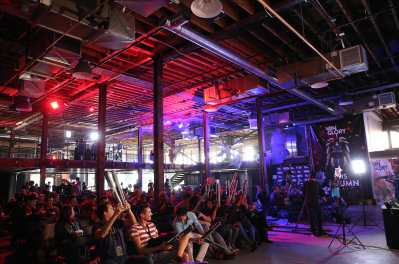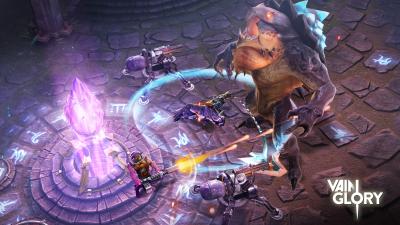SANTA ANA, Calif. — Nearly one year to the date in which Ben Watley discovered Vainglory and fell into its rabbit hole, he finds himself playing the game to a chorus of “oohs” and “ahhs” and reverberating claps from the thunder sticks in front of close to a hundred people in the eSports Arena.
His passion for the game has compounded into competition where he transforms into his gaming alter-ego “FooJee” as part of his co-owned team GankStars. Watley has travelled from San Francisco to take part in the game’s first ever North American tournament. His team is one of the top-eight that made the cut from the 650 applicants, with the winner earning $10,000.
It’s the first week of December, and Watley is passing out cardboard cutouts bearing his bearded face in a Santa hat to teenaged boys who hold it unwaveringly. For the 28 year-old seasoned tournament video game player, it might as well be Christmas morning.
In August, Watley, a former manager at Apple, turned to video games as a legitimate, full-time profession, a decision his wife Kirsten supports. But first, he and his two teammates, one who’s just 14, are hunched controlling a hero to shatter a giant crystal called the Vain in the center of the enemy team’s base. A commentary crew calls the action with the kind of fervor that you’d expect in a pay per view boxing match. Tens of thousands more are watching live online via Twitch.
“Ive always loved games, and the way they’ve engaged me and challenged me intellectually,” Watley said. “I see so much opportunity here, and I love eSports. This is a movement.”
 “I’m amazed by the turnout and the excitement here,” said Paul Ward, CEO of the eSports Arena. “This is the kind of event that opens the doors for others. The gaming culture has turned into popular culture.”
“I’m amazed by the turnout and the excitement here,” said Paul Ward, CEO of the eSports Arena. “This is the kind of event that opens the doors for others. The gaming culture has turned into popular culture.”
Watley, who’s team ended placing third and winning $1,500, is part of a larger eSports movement, specifically in the realm of mobile where the players are the tastemakers and influencers of the touch-screen generation. The eSports market is currently worth $747 million, according to SuperData Research, and it’s expected to grow 150 percent by 2018.
Enter companies like Super Evil Megacorp, who’re using smartphone-and-tablet exclusive games like Vainglory to make events for the masses more relatable, and inviting more people to be a part of the experience.
“There is a lot of promise to this kind of gaming environment. It’s accessible, more people have the devices, it’s more relatable, it’s in some ways more intuitive and learnable,” said Kristian Segerstrale, COO and executive director of Super Evil Megacorp. “One of the main driving reasons behind the game was that we felt like the touch-screen generation deserves the experiences and immersive franchises that (the previous generation) grew up on PC.”
Segerstrale says there will be nearly 3 billion touchscreens that will be capable of playing mobile games by the end of next year, compared to the estimated 700 to 800 million gaming PCs in the world.
“There’s a lot of promise in the touch-screen, competitive gaming industry,” Segerstrale, 38, says. “We grew up as PC gamers and want to replicate that experience. You can come together at any time as a team. Plus, you can see the player’s faces as they’re not obstructed by a monitor. There’s a human connection.”
Segerstrale describes the Vainglory community as an incredible, meaningful, long-lasting garden that’s continually tended. The game is not the type where you play for a couple of minutes for instant gratification, tap-to-win and log off. “We don’t really market the game, and don’t do TV advertisements or traditional user acquisition. We work with our community and help them find each other.”

It seems to be working. Sponsors like Amazon, Nvidia and Plantronics were out in full force for the tournament, held Dec. 4 to Dec. 6. (Liberation X defeated Nemesis Hydra for the $10,000 prize.) In November, the game was the No. 1 downloaded app in China for 10 consecutive days upon its Asiatic release, and in September, there were over one million unique users on Twitch, Segerstrale says.
The eSports market is an untapped one largely because developers have not realized the full potential of mobile. “It’s in the baby steps of becoming something gargantuan,” Watley said. “Once people learn to accept it, the obstacles are only what we make them. It’s just how fast technology can progress.”
“We’ve been blown away by how quickly the competitive scene has grown,” adds Segerstrale. “We were expecting to quietly grow in the community, and nurturing it over time. The growth has manifested itself in multiple ways as professional eSports organizations are getting involved. Another is sponsors who help fund events and teams. It offers legitimacy because a lot of the wonder: is this really a thing.”
Ward certainly thinks it’s a thing. He and a group of friends took the idea of an eSports facility that was three years in the making and opened a 15,000-sqaure foot red-brick building two months ago in Santa Ana.
“ESports is a key demographic for advertisers because players are hyper engaged and are early adopters and brands from big to small are noticing that,” said Ward. “If a brand associates with their community and their culture, gamers will have an affinity for them. It’s a very unique way to get in contact with potential customers.”
Ward, who once ran 200-person tournaments in college, says the last two months has “exceeded all of our expectations.” They’re already looking into bringing the big-venue feel that’s a throwback to the old-school land centers by expanding into locations in Austin, Chicago, Seattle and the Bay Area.
“We want to create a space where players, brands and game companies can come together and create a gaming community and culture around eSports,” said Ward. “We never wanted to replace the at-home gaming experience. We don’t think we can. We also know that we aren’t going to be a massive venue like the Staples Center. But we think there’s a lot of opportunities in between. It’s a unique platform for competition and expansion, and we’re very accessible.”
Segerstrale predicts a forward-thinking mobile game company will emerge in the next few years that will be three-to-five times the size from the biggest PC franchises. Can the one-year old Vainglory accomplish that
“We’re still in our humble infancy,” said Segerstrale. “We’re still babies when it comes to all of this. We’re learning. We’re really excited about the rapid growth of our garden.”

Kristian Segerstrale (far right) presents Liberation X with the grand prize.

